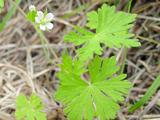Native Plants

Q. Who is Mr. Smarty Plants?
A: There are those who suspect Wildflower Center volunteers are the culpable and capable culprits. Yet, others think staff members play some, albeit small, role. You can torture us with your plant questions, but we will never reveal the Green Guru's secret identity.
Did you know you can access the Native Plant Information Network with your web-enabled smartphone?
Ask Mr. Smarty Plants is a free service provided by the staff and volunteers at the Lady Bird Johnson Wildflower Center.

rate this answer
Wednesday - January 16, 2008
From: Milford, CT
Region: Northeast
Topic: Wildflowers
Title: The most common wildflower in North America
Answered by: Nan Hampton and Joe Marcus
QUESTION:
Hi Mr. Smartyplants, What the most common wildflower in North America? My friend thinks it's the oxeye daisy. Is this correct? I work for a puzzle publishing company, and am doing research for a themed puzzle. The puzzle is about wildflowers. Hope you can help! Debra in Milford, CTANSWER:
The answer depends on how you define the terms, "common" and "wildflower." Many of the most "common wildflowers"—that is, species commonly called wildflowers and occurring in all 48 contiguous states—are of Old World origin. Many are also considered weeds. Among them are Oxeye daisy (Leucanthemum vulgare), Bull thistle (Cirsium vulgare), Bachelor's buttons (Centaurea cyanus), Queen Anne's-lace (Daucus carota), Henbit (Lamium amplexicaule), Dandelion (Taraxacum officinale) and Shepherd's purse (Capsella bursa-pastoris) that all came from Europe or Asia.
Native candidates that occur in all the "lower 48 states" (though all are not native to every state) are Common yarrow (Achillea millefolium), Carolina Crane's-bill (Geranium carolinianum), and Sleepy catchfly (Silene antirrhina).
For our money, however, the two most common wildflowers (herbaceous native plants with showy flowers) are Blackeyed Susan (Rudbeckia hirta) and Common sunflower (Helianthus annuus). Both occur all across America and in many places occur in vast numbers.
Good luck with your puzzle and we hope it includes lots of native wildflowers.
More Wildflowers Questions
Hardiness of bluebonnet seeds under water and white bluebonnets
April 30, 2007 - I was trying to find out more about the hardiness of bluebonnets. We own a lot on Lake Travis near Spicewood Texas. As you are probably aware, the lake was very low this spring due to a drought that ...
view the full question and answer
Survival of wildflowers after Hurricane Irene in Perkasie PA
September 03, 2011 - Mr. Smarty Plants,
We have (had) a beautiful row of wildflowers and sunflowers along the one side of our house. Now that Hurricane Irene has passed, most of the flowers are matted down from the wind...
view the full question and answer
Attracting butterflies in Tennessee
July 03, 2009 - What flowers and plants do the caterpillars in Tennessee eat? And do you know what butterflies live in Tipton Co. Tennessee?
view the full question and answer
Help for Collapsing Tradescantia
August 14, 2013 - My tradescantia has completely collapsed at the crown. The stems are yellowish. This happened once before when I had it planted in full sun and I just had to discard it. This time I have one plante...
view the full question and answer
Wildflower succession from Austin
April 02, 2011 - I am interested in learning about a wildflower "cycle" (not sure of a better term). I recently saw the Wildflower special on PBS that talked briefly about an area that had wildflowers that naturally...
view the full question and answer
| Support the Wildflower Center by Donating Online or Becoming a Member today. |

